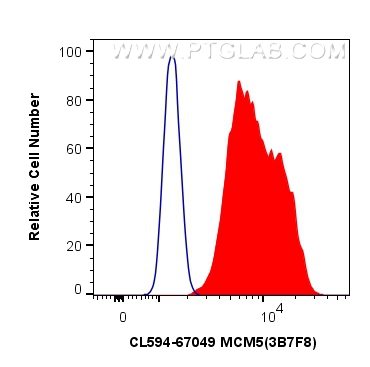验证数据展示
经过测试的应用
| Positive FC (Intra) detected in | MCF-7 cells |
| Positive FC detected in | MCF-7 cells |
推荐稀释比
| 应用 | 推荐稀释比 |
|---|---|
| Flow Cytometry (FC) (INTRA) | FC (INTRA) : 0.40 ug per 10^6 cells in a 100 µl suspension |
| Flow Cytometry (FC) | FC : 0.40 ug per 10^6 cells in a 100 µl suspension |
| It is recommended that this reagent should be titrated in each testing system to obtain optimal results. | |
| Sample-dependent, Check data in validation data gallery. | |
产品信息
CL594-67049 targets MCM5 in FC (Intra) applications and shows reactivity with Human samples.
| 经测试应用 | FC (Intra) Application Description |
| 经测试反应性 | Human |
| 免疫原 |
CatNo: Ag28704 Product name: Recombinant human MCM5 protein Source: e coli.-derived, PET28a Tag: 6*His Domain: 388-734 aa of BC000142 Sequence: SQLLKFVEKCSPIGVYTSGKGSSAAGLTASVMRDPSSRNFIMEGGAMVLADGGVVCIDEFDKMREDDRVAIHEAMEQQTISIAKAGITTTLNSRCSVLAAANSVFGRWDETKGEDNIDFMPTILSRFDMIFIVKDEHNEERDVMLAKHVITLHVSALTQTQAVEGEIDLAKLKKFIAYCRVKCGPRLSAEAAEKLKNRYIIMRSGARQHERDSDRRSSIPITVRQLEAIVRIAEALSKMKLQPFATEADVEEALRLFQVSTLDAALSGTLSGVEGFTSQEDQEMLSRIEKQLKRRFAIGSQVSEHSIIKDFTKQKYPEHAIHKVLQLMLRRGEIQHRMQRKVLYRLK 种属同源性预测 |
| 宿主/亚型 | Mouse / IgG1 |
| 抗体类别 | Monoclonal |
| 产品类型 | Antibody |
| 全称 | minichromosome maintenance complex component 5 |
| 别名 | CDC46, CDC46 homolog, MCM5, P1 CDC46 |
| 计算分子量 | 82 kDa |
| 观测分子量 | 82-88 kDa |
| GenBank蛋白编号 | BC000142 |
| 基因名称 | MCM5 |
| Gene ID (NCBI) | 4174 |
| RRID | AB_3084743 |
| 偶联类型 | CoraLite®594 Fluorescent Dye |
| 最大激发/发射波长 | 588 nm / 604 nm |
| 形式 | Liquid |
| 纯化方式 | Protein G purification |
| UNIPROT ID | P33992 |
| 储存缓冲液 | PBS with 50% glycerol, 0.05% Proclin300, 0.5% BSA, pH 7.3. |
| 储存条件 | Store at -20°C. Avoid exposure to light. Stable for one year after shipment. Aliquoting is unnecessary for -20oC storage. |
背景介绍
Minichromosome maintenance, S. Cerevisiae, homolog of 5(MCM5), one component of the complex of MCM2-7, which is the putative replicative essential for once per cell cycle DNA replication initiation and elongation in eukaryotic cells. The MCM complex form a hexameric ring through the interaction surfaces of two neighboring subunits.
实验方案
| Product Specific Protocols | |
|---|---|
| FC protocol for CL594 MCM5 antibody CL594-67049 | Download protocol |
| Standard Protocols | |
|---|---|
| Click here to view our Standard Protocols |


